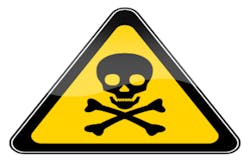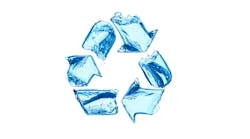Q.
What are algal toxins, how do they get into drinking water, what are their health concerns and what can be done to control them?
A.
They are real toxins and they can occur in drinking water when associated with algal blooms. Water treatment is possible but somewhat complicated. Monitoring has its complications. POU can help.
What are they?
Numerous algal blooms occur every summer in the U.S., including a major one a few months ago that resulted in a “do not drink” order and major economic consequences at the public water system on Western Lake Erie in Toledo, Ohio. Cyanobacteria are among the most genetically diverse microorganisms and they exist in almost all world locations and environmental niches, including extremes of heat and salinity. They are given credit for converting the earth from an anaerobic to aerobic environment by their ability to convert carbon dioxide into oxygen by photosynthesis. Some of them produce potent toxins. The most common algal toxins are microcystins, anatoxins, cylindrospermopsins and saxitoxins. Microcystins are usually found at the highest concentrations. Each of the toxins have congeners that are very similar chemical structures with differing toxicities.
Some people consume edible cyanobacteria as food or supplements. There are many projects underway attempting to cultivate algae as a source of biofuels including oils and alcohol, and some use sewage as a source of nutrients. Claims have been made that smaller areas of algae can produce significantly more biofuel than corn biomass conversion and with less energy required.
There are numerous algal toxins including those that occur in the sea (red tides), and those that are of concern in fresh waters that are drinking water sources and recreational waters. We will concentrate on the fresh waters, particularly those associated with blue-green algae, which are also called cyanobacteria. The name cyanobacteria is a bit confusing because it is related to the blue-green color (cyan) of the algae and has no association with cyanide. Some argue that technically algae (eukaryotes) are not as simple as bacteria (prokaryotes), but we won’t try to settle that academic debate.
Where and how do they grow?
Cyanobacteria are commonly present in surface waters and only some species produce toxins; however they become a significant problem when they proliferate and produce unsightly biomass (algal blooms) and release toxins, especially when they die and decompose. They proliferate under excessive nitrogen and phosphorus nutrient conditions, sunlight and usually in slow moving water. The cells lyse after death and release most of the accumulated toxins into the water; decomposition depletes the oxygen in the water and produces eutrophic conditions that are detrimental to the aquatic life.
How do they get into drinking water?
Drinking water treatment plants drawing from source surface waters prone to summer algal blooms have to contend with potential algal blooms and be prepared to respond rapidly. Observable source water conditions could include color, suspended cells and filaments, surface scum and huge masses of aggregated algae. Frequently production of potent taste and odor producing compounds like geosmin and 2-methylisoborneol occur, generating musty off tastes in the drinking water that some people can detect at less than 20 ppt.
Water Treatment
Water treatment approaches include physical removal, chemical conversion and adsorption.
Conventional treatment that includes coagulation, flocculation, sedimentation and chlorine disinfection can remove most of the algal cells, but toxin removal is more problematic. It is essential to remove the algal cells by filtration prior to the addition of any oxidant such as chlorine. The oxidant will lyse the cells and release the toxins into the drinking water.
Oxidants/disinfectants such as chlorine, chloramine, chlorine dioxide, ozone, potassium permanganate and ultraviolet (UV) light are frequently available in a water treatment facility, or can be added, and provide a range of efficacies against the toxins. The following relate to Microcystin-LR, which is a common form and among the most potent:
- Ozone will rapidly lyse the cells; it is effective against the toxin at ozone doses of five ppm or less and at very low concentration-time values (CT in mg-min/l). CT means concentration in mg/l x time in minutes, so for example, a concentration of one mg/l for 10 minutes would be the same as 10 mg/l for one minute. Elimination of Microcystin-LR is virtually instantaneous.
- Potassium permanganate will lyse the cells and is also a very effective, rapid treatment for the toxin. The CT value for complete elimination is about 25 mg-min/l.
- Free chlorine will lyse the cells and it is very effective, achieving nearly complete elimination at CT of about 60 mg-min/l. Chlorine is present in almost every surface water treatment plant and probably functions both as an oxidizing and chlorinating agent.
- Chlorine dioxide is a good disinfectant and lyses cyanobacteria cells, but it has no reactivity toward the toxin.
- Monochloramine has some reactivity against the cells but not towards the toxin.
- UV light irradiation at high doses has a destructive effect on the cells but does not affect toxin concentrations.
Membranes such as reverse osmosis (RO), nanofiltration, ultrafiltration and microfiltration are all effective for the removal of cells. Pretreatment and frequent cleaning could be necessary. RO and nanofiltration, but not microfiltration, would be effective for toxin removal.
Adsorption using powdered activated carbon is a short term technique for the removal of geosmin, 2-methylisoborneol and toxins. However, the efficacy is variable and is affected by water quality factors. Granular activated carbon (GAC) is effective if the filter is of sufficient depth and condition but it is subject to exhaustion and exceeding capacity. Only a few GAC systems are in place in the U.S. that are regularly/frequently reactivated; most applications are in shallow fixed beds for routine taste and odor control and not reactivated for years, so their performance is not generally predictable in a sustained algal bloom. Biological activated carbon filters would be more likely to have sustained performance without frequent reactivation, because they usually incorporate ozone that would react with the toxins and provide the opportunity for microbial degradation of chemicals on the GAC surface.
Analytical methods
Microcystins can be analyzed by liquid chromatography linked with tandem mass spectrometry (LC/MS/MS). It allows analyses of several algal toxins with minimum detection limits in the vicinity of 0.01 µg/l (10 ppt). The quicker, non-specific technique is called enzyme linked immunosorbant assay (ELISA). It uses an antigen-antibody reaction to detect antigen components reactive to the particular antibody that is immobilized on a solid phase. It is less specific than LC/MS/MS and can over count. A mouse bioassay is used in screening, as well as a protein phosphatase assay that is sensitive to sub microgram levels.
Toxicity of Microcystin-LR
Microcystins have 80-90 congeners and also appear to be the most common, among the most frequently detected and amid the most toxic; its molecular weight is approximately 1,000 daltons. Concentrations can range from single digits to many hundreds of micrograms per gram dry weight. Raw water samples are usually in single digit micrograms per liter but have been reported in the hundreds in some cases. Elimination mechanisms include biodegradation and photolysis, however they can be persistent in the water for days.
Human illnesses and some animal deaths have been reported on several continents in recreational exposures — where human exposure can occur by skin contact as well as inadvertent ingestion. Symptoms include nausea, abdominal pain, vomiting, diarrhea, sore throat and blistering at the mouth. A large outbreak occurred in Brazil in 1988.
Microcystin-LR is a hepatotoxin with reported mouse LD-50 of about 5,000 µg/kg body weight, and higher in the rat. Sub chronic toxicity (13 week) was tested in groups of 15 male and 15 female mice exposed at 0, 40, 200 or 1,000 µg/kg body weight per day. The no-observed-adverse-effect level (NOAEL) was 40 µg/kg/day; one male and two females in the 200 µg/kg/day group showed slight liver pathology; all mice at the highest dose showed liver changes. In other studies, young mice were less affected than older mice. Groups of five pigs were tested for 44 days at several doses with an extract of Microcystis aruginosa. The lowest-observed-adverse-effect-level (LOAEL) was 280µg/kg/day with one pig showing liver effects. In a longer term study, three velvet monkeys were exposed by gavage three days per week for 46 weeks to increasing doses from 20 to 80 µg/kg/day. No statistically significant changes were observed. No toxicity was observed during an up to 18 month study in female mice consuming drinking water containing 20 µg/l of Microcystin-LR/l.
Guidelines
The World Health Organization Drinking Water Guideline is one µg/l as a lifetime Tolerable Daily Intake for a 60 kg adult consuming two l/day. It was based upon the 13 week mouse study and incorporated an uncertainty (safety) factor of 1,000. It would be considered conservative. In the Toledo case the no-drink order was issued for exceeding one µg/l and lasted for about two to three days. It referred to the WHO Guideline but perhaps misinterpreted the meaning of Tolerable Daily Intake to apply for any day, rather than per day for chronic (lifetime) exposure, or it was an example of extreme conservatism.
POU/POE
Because these tend to be large molecules, both carbon and RO technology should be effective. The carbon would be subject to exhaustion and the RO has a very high water reject ratio.
Additional information
- Cyanobacterial Toxins — Microcystin-LR. Health Canada, www.hc-sc.gc.ca/ewh-semt/pubs./water-eau, Archived June 24, 2013.
- Guidelines for Drinking Water Quality. World Health Organization. 4th edition, 2011.
- World Health Organization Cyanobacterial toxins: Microcystin-LR in Drinking Water. WHO/SDE/WSH/03.04/57, 1998.
- Release and Removal of Microcystins from Microcystis during Oxidative, Physical and UV based Disinfection. J Ding, H Shi, T. Timmons, and C Adams. J. Env. Eng. 2-11, January 2010.
- USEPA Policies and Guidelines, www2.epa.gov/nutrient-policy-data/policies-and-guidelines.
- Cyanobacteria and Cyanotoxins: Information for Drinking Water Systems. EPA-810F11001. July 2012.
Dr. Cotruvo is president of Joseph Cotruvo and Associates, LLC, Water, Environment and Public Health Consultants. He is a former director of the U.S. EPA Drinking Water Standards Division.


